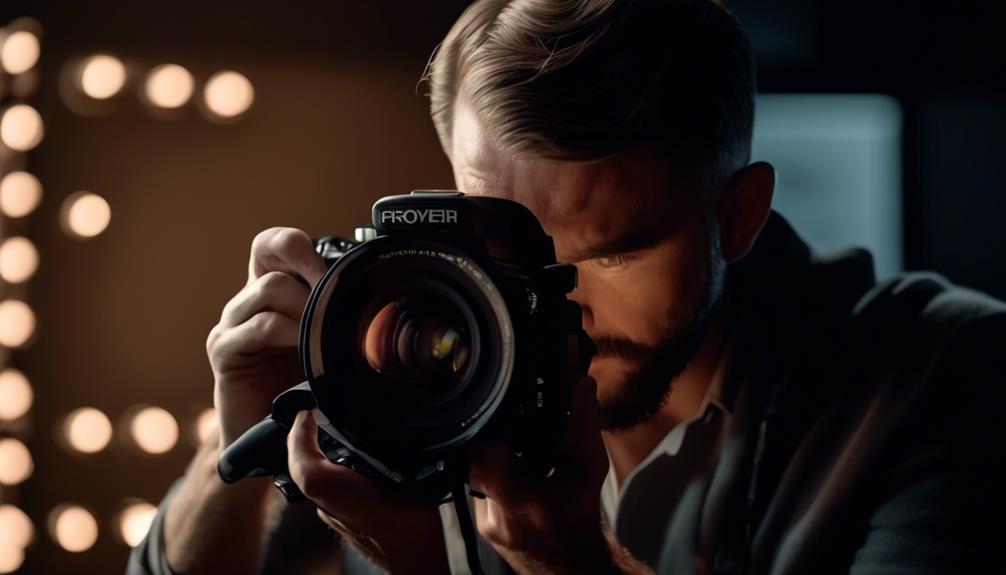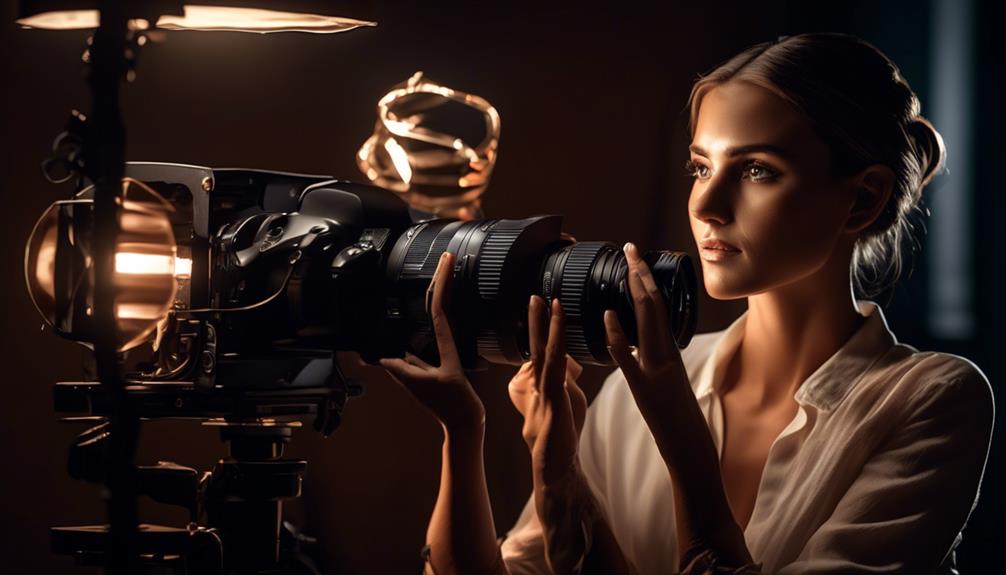Please note this post may contain affiliate links picked by me (Jay) that I have deemed may be of interest or relevant to you the reader of this.
These links do not affect the cost of the thing if you decide to purchase but i may get a little money if you choose to purchase.
For more information on my affiliate link policy click here.
I know what you're thinking. Portrait lighting can be a tricky subject, and it's easy to get overwhelmed by all the technical jargon and equipment. But fear not, because I'm here to simplify the process for you.
In this discussion, I will share three key tips that will help you elevate your portrait lighting game. These tips are not only practical, but they will also empower you to create stunning, professional-looking portraits.
So, if you're ready to take your photography to the next level and make your subjects truly shine, then keep reading. You won't want to miss these game-changing techniques.
Key Takeaways
- Understanding the different types of light bulbs and their characteristics can help in choosing the right lighting for portrait photography.
- Mastering lighting techniques such as backlighting, low key lighting, diffused light, and experimenting with angles and distances can greatly enhance portrait photographs.
- Utilizing light modifiers like softboxes and beauty dishes can provide versatile and desired effects in portrait lighting.
- Controlling and shaping light is crucial in portrait photography, and different light modifiers can help achieve the desired quality and direction of light.
Understanding Light Sources
Understanding light sources is essential for achieving captivating and dynamic portrait lighting. As a photographer, I've always been fascinated by the interplay between light and shadows, and how they can transform a simple photograph into a work of art. When it comes to portrait photography, the choice of light source is crucial in creating the desired mood and effect.
Let's explore the different types of light bulbs and the distinction between natural and artificial lighting.
When it comes to light bulbs, there are various options available, each with its own unique characteristics. Incandescent bulbs, for example, produce a warm and soft light that can create a cozy and intimate atmosphere. On the other hand, fluorescent bulbs emit a cooler light, which is often used in commercial settings for its bright and even illumination. LED bulbs, known for their energy efficiency and long lifespan, have become increasingly popular in recent years due to their versatility and ability to produce different color temperatures.
In portrait photography, the choice between natural and artificial lighting depends on the desired outcome. Natural lighting, such as sunlight, can create stunning portraits with its soft and diffused quality. It can be used to highlight the subject's features and create a natural, organic feel. On the other hand, artificial lighting allows for more control and precision. Studio lights, for example, can be adjusted to create various lighting setups, such as Rembrandt, butterfly, or split lighting, enhancing the subject's features and creating a dramatic effect.
Understanding the characteristics and possibilities of different light sources is crucial in achieving innovative and captivating portrait lighting. Whether it's experimenting with different types of light bulbs or harnessing the power of natural or artificial lighting, the key lies in finding the perfect balance that elevates your portraits to the next level.
Mastering Lighting Techniques
Now that we've explored the different types of light sources and their unique characteristics, it's time to dive into the exciting world of mastering lighting techniques in portrait photography.
When it comes to perfecting the art of backlighting portraits, there are a few key techniques to keep in mind. First, positioning your subject in front of a strong light source, such as the sun, can create a beautiful halo effect, highlighting their features and adding depth to the image. Experimenting with different angles and distances between the subject and the light source can produce varying results, so don't be afraid to play around and find what works best for you.
Creating dramatic effects with low key lighting techniques is another skill that can take your portraits to the next level. This involves using a single, focused light source to illuminate only specific areas of the subject's face or body, leaving the rest in shadow. This can create a sense of mystery and intrigue, adding depth and dimension to your photographs. Experiment with different lighting modifiers, such as grids or snoots, to control the direction and intensity of the light.
In addition to backlighting and low key lighting, mastering the use of diffused light and fill light can also greatly enhance your portraits. Diffused light, achieved by using a softbox or umbrella, creates a soft and even illumination, minimizing harsh shadows and creating a flattering effect. Fill light, on the other hand, can be used to balance out the overall lighting by filling in any areas of shadow, ensuring that every detail is captured.
Utilizing Light Modifiers
Light modifiers are essential tools in portrait photography that allow photographers to shape and control the quality and direction of light. They're the secret weapons that elevate ordinary portraits into extraordinary works of art. By using light modifiers strategically, you can create stunning visuals that captivate your audience and leave a lasting impression.
One of the most commonly used light modifiers is the softbox. Softboxes are versatile tools that produce soft, diffused light. They come in various shapes and sizes, allowing for creative freedom and flexibility in your portrait lighting setup. The placement of the softbox plays a crucial role in achieving the desired effect. Placing it close to your subject creates soft, flattering light that minimizes harsh shadows and emphasizes facial features. Moving it farther away produces a broader, more even spread of light.
Another popular light modifier is the beauty dish. This unique tool creates a distinct look by providing a combination of soft and directional light. It produces a stunning wrap-around effect that enhances facial features and brings out the subject's natural beauty. The beauty dish is ideal for portrait photography, especially in fashion and beauty shoots, as it adds a touch of glamour and sophistication to the images.
Understanding the effects of different light modifiers is essential for creating visually striking portraits. Experiment with different softbox placements and beauty dish effects to find the perfect combination that suits your style and vision. Don't be afraid to push the boundaries and explore new techniques. Innovate, experiment, and let your creativity shine through your portraits. Remember, light modifiers are your artistic tools to shape and mold light into breathtaking masterpieces.
Frequently Asked Questions
How Can I Achieve Dramatic Lighting Effects for Portrait Photography?
To achieve dramatic lighting effects for portrait photography, I've found that playing with low key lighting and high key lighting can make a huge difference.
By using low key lighting, where there's a lot of contrast and shadows, you can create a moody and mysterious atmosphere.
On the other hand, high key lighting, with bright and even illumination, can give your portraits a clean and ethereal look.
Experimenting with these techniques will elevate your portraits to a whole new level of creativity and impact.
What Are Some Common Mistakes to Avoid When Using Artificial Lighting for Portraits?
One common mistake to avoid when using artificial lighting for portraits is overexposure. It's important to properly expose your subject and avoid blowing out the highlights.
Another mistake is using harsh, direct lighting that creates unflattering shadows. Instead, try diffusing the light or using reflectors to create softer, more flattering light.
Finally, be mindful of the color temperature of your lighting. Mixing different light sources can result in unnatural color casts.
Are There Any Specific Lighting Setups That Work Best for Different Facial Features?
When it comes to lighting setups for different facial features, there are definitely some tips that can help create more flattering portraits.
It's important to consider the shape of the face and the desired effect you want to achieve. For example, a broad lighting setup can soften angular features, while a short lighting setup can add depth and dimension to a round face.
Experimenting with different lighting angles and modifiers can truly elevate your portrait game.
How Can I Effectively Use Natural Light for Outdoor Portrait Photography?
When it comes to outdoor portrait photography, harnessing the power of natural light is key. Maximizing the golden hour lighting, that magical time just after sunrise or before sunset, can give your portraits a warm and ethereal glow.
But challenges arise when dealing with harsh sunlight. To overcome this, try finding shaded areas or using diffusers to soften the light.
What Are Some Advanced Portrait Lighting Techniques That Professionals Use to Create Stunning Images?
When it comes to capturing stunning portrait images, professionals utilize advanced lighting techniques that truly elevate the final result. By mastering the art of controlling light and shadow, they're able to create unique and expressive portraits.
These creative lighting techniques not only add depth and dimension to the subject's features but also bring a sense of innovation and artistry to the photographs. It's truly fascinating how professionals can manipulate light to capture the essence and beauty of their subjects.
Conclusion
So there you have it, my fellow portrait photographers. By understanding light sources, mastering lighting techniques, and utilizing light modifiers, you too can elevate your portrait lighting game to new heights.
Remember, it's not just about illuminating your subject; it's about capturing their essence and telling their story through the play of light and shadow.
So go forth, experiment, and let your portraits shine with a luminosity that will make even the sun jealous.
Happy shooting!


